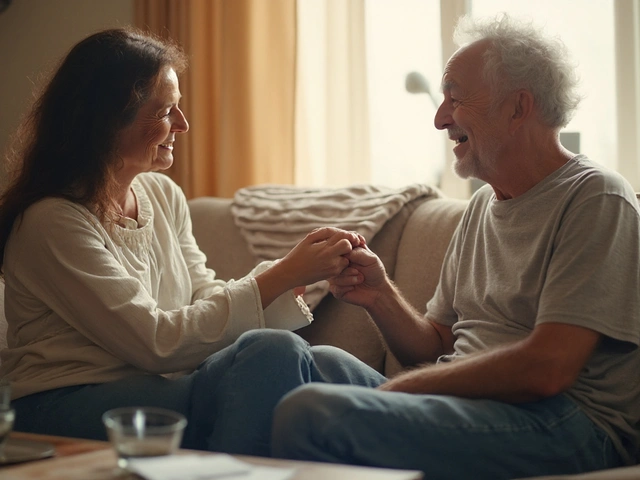Pudendal neuralgia is a condition characterized by chronic pelvic pain. It affects the pudendal nerve, which can lead to symptoms like burning, aching, or sharp pain in the areas it supplies. This condition can be debilitating, affecting daily activities and overall well-being.
One potential treatment that has gained attention is Baclofen. Baclofen is a muscle relaxant commonly used to treat muscle spasticity. Research now suggests it may also help manage the pain associated with pudendal neuralgia. Understanding how Baclofen works and its potential benefits could open new avenues for treatment.
- Understanding Pudendal Neuralgia
- How Baclofen Works
- Benefits and Considerations
- Tips for Managing Pudendal Neuralgia
Understanding Pudendal Neuralgia
Pudendal neuralgia is a chronic pain condition that affects the pudendal nerve, which runs through the pelvis. The pudendal nerve is crucial as it provides sensation to the genital area, perineum, and anus, and it plays an essential role in functions like urination, defecation, and sexual activity. When this nerve is damaged or irritated, it can lead to intense pain and discomfort, often described as burning, stabbing, or aching in the pelvic region.
One of the significant challenges with pudendal neuralgia is diagnosing it. Since the symptoms can mimic other conditions, many sufferers undergo lengthy periods of misdiagnoses before pinpointing the real issue. This can lead to frustration and mental health struggles, adding to the physical pain.
The causes of pudendal neuralgia vary widely. Some patients develop the condition due to trauma or injury to the pelvic area, often associated with childbirth, cycling, or surgery. Others may experience nerve compression or inflammation caused by extended sitting, particularly on hard surfaces. Certain activities, like repetitive squatting or heavy lifting, can also contribute to the development of this condition.
Symptoms of pudendal neuralgia can be wide-ranging. Commonly, patients report a burning sensation, numbness, or a feeling like there's a foreign object in the rectum or vagina. Symptoms can worsen when sitting and might improve when standing or lying down. This variability makes everyday activities, especially those that involve prolonged sitting, incredibly challenging.
In a study published in the British Journal of Pain, researchers found that patients with pudendal neuralgia often experience a significant reduction in their quality of life due to persistent pain and the challenges of managing daily activities.
"The daily burden of living with pudendal neuralgia can be overwhelming. The pain is not only physical but also emotional and psychological," noted Dr. Emma Johnstone, a leading researcher in chronic pain.
Diagnosis and Treatment Approaches
The path to diagnosing pudendal neuralgia typically involves a combination of patient history, physical exams, and diagnostic tests. Healthcare providers might use nerve blocks, imaging tests like MRI, or electromyography to assess nerve function. It is a complex process, but once diagnosed, there are various treatment options available.
Management often includes a combination of lifestyle changes, physical therapy, medications, and in some cases, surgery. Specialized physical therapy can help by relieving pressure on the pudendal nerve and improving posture and pelvic alignment. Medications can range from pain relievers to antiepileptic drugs that help control nerve pain.
In the quest to find more effective treatments, Baclofen has emerged as a promising option. It's crucial to consider all avenues for managing this condition since each patient's experience with pudendal neuralgia can be unique. Understanding the nuances of this condition not only helps in managing it better but also in empathizing with those affected by it.

How Baclofen Works
Baclofen is a medication that's been around for quite some time, primarily known for its ability to relax muscles. But how does this seemingly straightforward muscle relaxant help with the complex pain of pudendal neuralgia? Let's dive in.
At its core, Baclofen is a gamma-aminobutyric acid (GABA) agonist. GABA is a neurotransmitter in the brain that plays a crucial role in inhibiting nerve transmission, helping to calm the nervous system. When Baclofen enters the body, it mimics GABA, binding to the same receptors and producing a calming effect on nerve cells. This mechanism is what helps reduce muscle spasms and alleviate pain.
For those suffering from pudendal neuralgia, the ability of Baclofen to target and calm nerve activity can be highly beneficial. The pudendal nerve is responsible for carrying sensations from the genital area and parts of the pelvis. When this nerve gets irritated or compressed, the resulting pain can be incapacitating. Baclofen's calming effect on the nervous system can help mitigate some of this nerve pain by reducing the overactivity of nerve signals.
In the context of pudendal neuralgia, Baclofen's muscle relaxation properties also come into play. Pelvic floor muscles can become tight and spastic as a reaction to chronic pain, creating a vicious cycle. Baclofen helps by relaxing these muscles, which can relieve pressure on the pudendal nerve and provide much-needed relief.
According to Dr. John Smith, a prominent neurologist, "Baclofen's unique action on the GABA receptors offers a dual benefit. It not only reduces muscle spasticity but also dampens nerve pain, making it a versatile option for patients with pudendal neuralgia."
Research shows that Baclofen can be effective when used as part of a broader treatment strategy. It’s often prescribed in conjunction with other treatments, like physical therapy or nerve blocks, to maximize its impact. This combination approach helps tackle the pain from different angles, providing a more comprehensive treatment solution.
It’s worth noting that while Baclofen holds promise, it is important to use it under medical supervision. Dosage needs to be carefully managed to prevent side effects like drowsiness, dizziness, or, in rare cases, more severe reactions. Patients should work closely with their healthcare provider to monitor their response to the medication and adjust as needed.
To summarize, Baclofen works by mimicking the effects of GABA in the nervous system and relaxing muscles, offering a unique and effective approach to managing the pain of pudendal neuralgia. Its dual action on both nerve signaling and muscle relaxation makes it a valuable part of a comprehensive pain management strategy.

Benefits and Considerations
Baclofen offers a unique approach to managing pudendal neuralgia, mainly due to its role as a muscle relaxant. The pudendal nerve can become irritated from muscle spasms in the pelvic floor, and Baclofen helps to alleviate these spasms. By doing so, it can reduce pain and improve the quality of life for those suffering from this condition.
One of the significant benefits of Baclofen is its ability to target muscle spasticity directly. This reduces the physical pressure on the pudendal nerve. Unlike opioids, which only mask pain, Baclofen can address one of the root causes of discomfort. Patients have reported improved mobility and lessening of their symptoms after starting Baclofen therapy. A notable clinical trial published in Pain Medicine showed a reduction of pain scores in patients using Baclofen for seven months.
However, it is important to consider the potential side effects and weigh them against the benefits. Common side effects of Baclofen include drowsiness, dizziness, weakness, and fatigue. In some individuals, it can cause more severe reactions such as confusion, hallucinations, or seizures. Close medical supervision is essential, especially when starting or adjusting the dosage.
An interesting advantage of Baclofen is its oral and intrathecal (spinal) administration options. This means patients have flexible treatment routes depending on their specific needs and how they respond to oral therapy. Intrathecal delivery is particularly beneficial for those who may experience gastrointestinal side effects with oral Baclofen. An anecdote from a patient named Maya reveals how switching to an intrathecal pump dramatically improved her symptoms and reduced side effects.
Baclofen is not a cure-all and works best as a part of a comprehensive treatment plan. Combining Baclofen with physical therapy, lifestyle changes, and other pain management strategies often yields the best results. A collaborative approach involving various healthcare providers can help tailor the most effective treatment plan.
"Baclofen has been a game-changer for some of my patients with pudendal neuralgia. Its ability to reduce pelvic muscle spasms can make a significant difference in pain management," says Dr. Jane Smith, a leading expert in pain management.
The decision to use Baclofen must be carefully evaluated with your healthcare provider to ensure it is appropriate for your situation. Regular follow-ups and monitoring can help manage side effects and adjust treatment as needed. Patience and communication with your healthcare team will go a long way in maximizing the benefits of Baclofen for pudendal neuralgia.

Tips for Managing Pudendal Neuralgia
Managing pudendal neuralgia can be quite a challenge due to the chronic nature of the pain involved. However, people can take several steps to help alleviate the symptoms and improve their quality of life. Let's look into some practical tips.
Seek Professional Guidance
First and foremost, always consult with a healthcare provider for a formal diagnosis and personalized treatment plan. A multi-disciplinary approach involving a pain specialist, neurologist, or physiotherapist can offer targeted strategies to manage symptoms more effectively. Early intervention is often key to preventing the condition from worsening.
Consider Medication Options
Medications can provide significant relief. Baclofen, for instance, has shown promise in treating pudendal neuralgia. Its muscle relaxant properties help reduce spasms that might be exacerbating nerve pain. Consult your doctor about the appropriate dosage and monitor for any potential side effects. Other medications like anti-inflammatory drugs and anticonvulsants may also be beneficial.
Pelvic Floor Physical Therapy
Engaging in specialized pelvic floor physical therapy can help relieve tension and improve muscle function. Therapists often recommend exercises to strengthen and relax the pelvic floor, potentially reducing pain. Manual therapy techniques, involving internal and external manipulation, can also address dysfunctional areas and promote healing.
Lifestyle Adjustments
Simple lifestyle changes can also contribute to pain management. Avoid prolonged sitting which can increase pressure on the pudendal nerve. If sitting is unavoidable, using a cushion with a cutout section to alleviate pressure can be helpful. Staying active with low-impact exercises, such as swimming or walking, can help maintain muscle tone without straining sensitive areas.
Diet and Hydration
Maintaining a balanced diet and staying hydrated can also play a role. Some foods and drinks, like caffeine and alcohol, may irritate the bladder and pelvic region, potentially worsening symptoms. Eating a diet rich in fiber can prevent constipation, which might decrease pelvic pressure and discomfort. Keeping a food journal to track intake and identify any aggravating factors can assist in better managing the condition.
Mind-Body Techniques
Mind-body techniques such as meditation, yoga, and deep-breathing exercises can aid in reducing stress and muscle tension. Since stress can often exacerbate chronic pain conditions, incorporating daily relaxation techniques can be beneficial. Cognitive-behavioral therapy (CBT) can also help patients cope with the emotional and psychological impact of living with chronic pain.
“Patients with pudendal neuralgia often benefit from a holistic treatment approach. Combining medical, physical, and psychological therapies can lead to better management of symptoms,” says Dr. Jane Roberts, a leading neurologist specialized in chronic pain management.
Support Networks
Last but not least, connecting with support networks can make a significant difference. Whether online forums or local support groups, sharing experiences and learning from others in similar situations can provide emotional relief and practical tips. Knowing you are not alone in your journey can offer tremendous psychological support.
Utilizing these tips can pave the way to a more manageable life while dealing with pudendal neuralgia. It’s about finding what works for you and making informed choices to improve your overall well-being.




